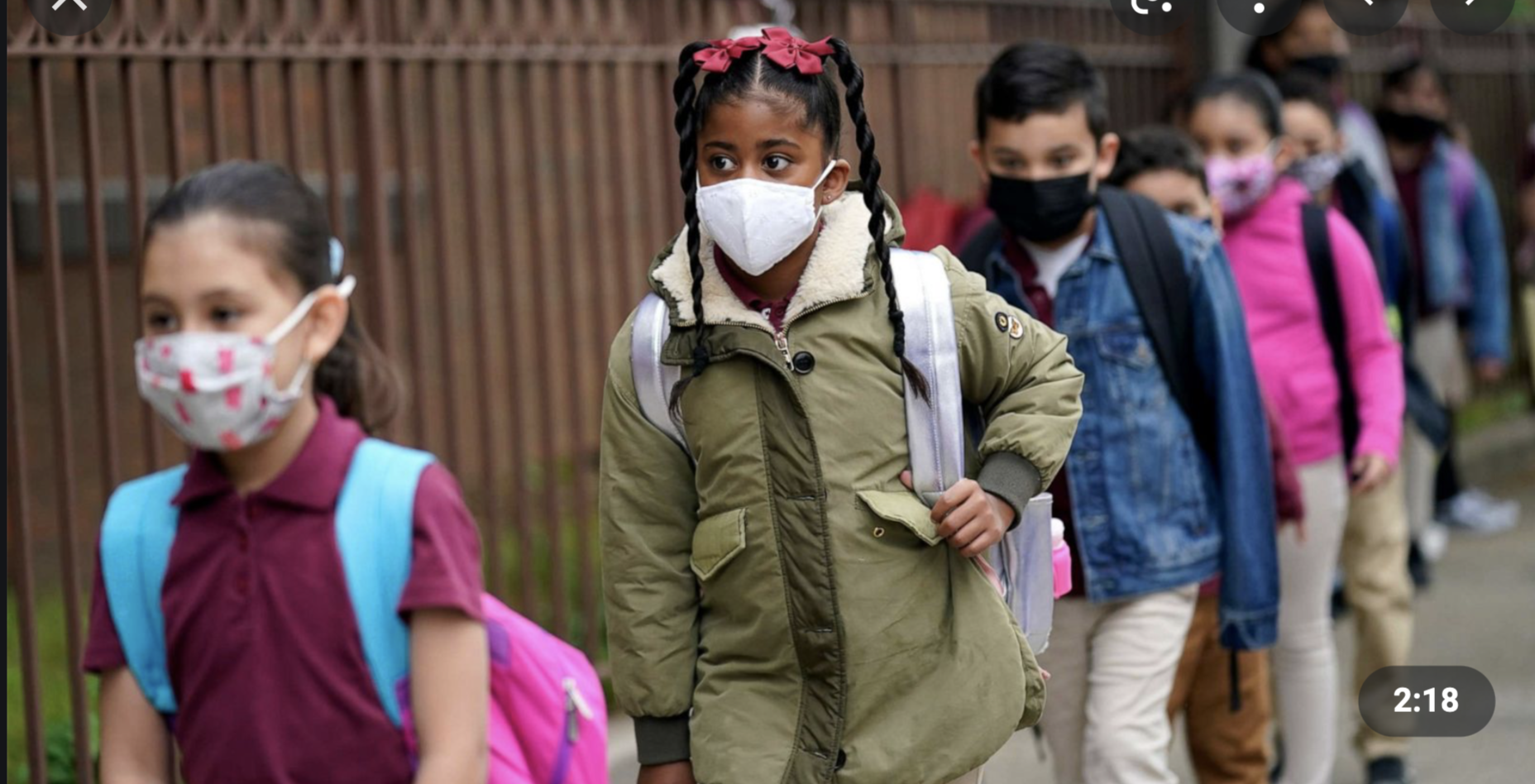City Journal: Kids Full of Life, Adults Obsessed with Death
/The Insanity of Masking Children
Children are perhaps the most-masked people in America, and clearly the people least needing to be masked. Whether or not one believes that masks work—and the best available scientific research suggests, as I have detailed in City Journal, that surgical and cloth masks provide little to no benefit in stopping the spread of viruses and might even be counterproductive—kids are plainly the least likely to be struck ill by Covid and probably the least likely to spread it.
There’s an extraordinary difference—even greater than widely recognized—between Covid-19’s effects on kids and its effects on adults, as fatality numbers show. Far from regarding this important fact as a godsend for the upcoming generation, however, many policymakers have treated it as an irrelevancy. At the same time, they have ignored that children living in mask-mandate states have had essentially identical Covid fatality rates as kids living in mask-free states.
Policymakers in mask states—who, when it comes to Covid, are almost always governors, public-health officials, or public school administrators, rather than representative legislators—suggest that children are resilient, that whatever doesn’t kill them will make them stronger. The truth is almost surely the opposite. Being taught to cower in the face of Covid, while being told not to show one’s own face or interact with the faces of others, is not making these kids stronger. It is not making them more socially adept. It is stunting their growth, stifling their potential, and sapping their happiness.
Kids shouldn’t have to wear masks in the classroom, on the playground, on sports courts or fields, or just about anywhere else that they might learn, run, play, or flash their joyful, infectious smiles—so full of life when not blocked by adults so preoccupied with death. In general, Covid is mercifully sparing kids, yet adults are seemingly, inexplicably, targeting them, making them suffer needlessly and in defiance of the data—that is, in defiance of the science.
Based on statistics provided by the Centers for Disease Control and Prevention (CDC), a 74-year-old who dies of Covid-19 is slightly younger than the median—or typical—Covid victim has been in the United States. Out of every 1,000 people who have died of (or with) Covid in the U.S., 515 have been at least 75 years old, 484 have been adults under the age of 75, and one has been a kid (someone under the age of 18).
In fact, people who have died of Covid-19 in the U.S. have been split about evenly into four age groups: About a quarter (26 percent) have been at least 85 years old, about a quarter (26 percent) between 75 and 84, about a quarter (23 percent) between 65 and 74, and about a quarter (25 percent) between 30 and 64. Less than one percent (0.7 percent) of Covid deaths in the U.S. have involved someone under the age of 30, and most of those have involved someone between the ages of 25 and 29. Again, that’s based on the CDC’s numbers.
Across the more than two years from January 1, 2020 to January 15, 2022, per the CDC’s statistics and population figures from the U.S. Census Bureau, 99.7 percent of adults did not die of Covid—either because they didn’t get it, or because they got it and survived it. Meanwhile, 99.999 percent of kids (those under 18) did not die of Covid. The portion of adults who did die of Covid was 0.33 percent. The portion of kids who died of Covid was 0.00098 percent.
Clearly, these are not small differences. Indeed, the heightened danger that Covid poses to the old in relation to the young is somewhat amazing. In the U.S., those age 85 or older have had more than 3,000 times the chance of dying of Covid-19, per capita, as those under the age of 18. Even those in their thirties have had 35 times the chance of dying of Covid-19, per capita, as those under 18.
As well as providing figures on kids ages 0-17, the CDC narrows its national statistics to the age range of most school-age kids—those ages 5–17. These stats reveal that, through January 15 of this year, 99.95 percent of Covid-related deaths in the U.S.—or 1,839 out of every 1,840 Covid-related deaths—were not of school-age kids.
Some might be surprised to learn that Covid has not even been the cause of the majority of deaths of school-age kids during the Covid period. More might be surprised to learn just how far this has been from being the case: out of every 50 school-age kids (ages 5–17) who have died during the Covid period, only one has died of (or with) Covid. Again, that’s based on the CDC’s statistics.
These are nationwide statistics. But, of course, there has been a huge difference in mask policies toward kids—and others—across the several states. Under Governor Ron DeSantis, Florida’s children have lived freely, except in particular localities that have imposed their own mandates. Under Governor Gavin Newsom, by contrast, California’s kids have lived a masked existence, with partial exceptions in counties (such as Orange) where Newsom’s decrees have been only loosely enforced.
Children’s lives have been radically different in these two states. As long as they haven’t ventured into Walt Disney World—which apparently thinks that required mask-wearing is compatible with being the most magical place on earth—kids in Florida have been free to live like kids. In California, however, unless they’ve been raised in a liberty-loving place like Huntington Beach and been home-schooled, children have been forced to live like minimum-security prisoners.
The result? From January 1, 2020, to January 15, 2022, 99.999 percent of kids in California didn’t die of Covid—either because they didn’t get it, or because they recovered from it. Over that same span of time, 99.999 percent of kids in Florida didn’t die of Covid. Both states’ numbers matched the national average. So, where would you rather be growing up?
Or take two adjacent states with very different attitudes toward the masking of the American kid. Under Governor Kate Brown, Oregon’s schoolchildren are required to be masked in schools, as well as when they enter other buildings apart from private residences. Directly across Oregon’s eastern border, meantime, under Governor Brad Little, Idaho has not had a mask mandate at any time during the pandemic, either in or out of schools.
From January 1, 2020, to January 15, 2022, Oregon had just two Covid-related deaths of kids (those under age 18); Idaho, with about half the population, had just one—giving kids in each state a Covid survival rate of 100.000 percent, or 99.9998 percent when taken out to the fourth decimal point. A huge difference in freedom produced no difference in fatality rates.
To its credit, Oregon at least doesn’t require mask-wearing for those playing any level of competitive sports—such as basketball—which is more than can be said for many localities across the nation. Vying for worst school district in the country, the giant Los Angeles Unified School District has recently extended its mask decree to children playing sports outdoors, declaring, “Masking will be required at all times, indoors and outdoors”—and adding, “Students will be required to wear a non-cloth mask with a nose wire at all times, including while participating in athletic activities.”
The results seen when comparing Oregon and Idaho, and California and Florida, are consistent with what’s found nationwide. In total, 16 states, plus the District of Columbia, had statewide (or district-wide, in D.C.’s case) school mask mandates in place as of mid-January of this year. (These included the Eastern Seaboard, from Virginia to Massachusetts; Illinois, Louisiana, New Mexico, and Nevada; the three Pacific Coast states; and Hawaii.) The CDC doesn’t provide stats on kids’ deaths for the two smallest of these states: Rhode Island and Delaware. In the other 14 mask-mandate states plus D.C., taken in combination, 99.999 percent of kids didn’t die of Covid between January 1, 2020, and January 15, 2022.
Meantime, 34 states did not have statewide school mask mandates in place as of mid-January. The CDC doesn’t provide stats on kids’ deaths for one of these states: Maine. In the other 33 free states, taken in combination, 99.999 percent of kids didn’t die of Covid—the same percentage as in the mask-mandate states over the same span of time.
The place with the worst stats is Washington, D.C.—which has been at least as heavily masked and locked down as any of the 50 states—where 99.996 percent of kids have not died of Covid. The states with the best stats are Wyoming, Vermont, and New Hampshire—which didn’t have statewide school mask mandates in place as of January 15, 2022, and where no children have died of Covid throughout the Covid period.
Someone I know in Virginia—where incoming Governor Glenn Youngkin just overturned outgoing Governor Ralph Northam’s school mask mandate—recently emailed me about his five-year-old daughter’s response to masks. When his wife told their daughter that she no longer had to wear a mask in the school where her mom teaches, their daughter—who still has to wear a mask at her private preschool—replied, “But everyone will see my mouth!”
One has to have an extremely impoverished view of human social interaction not to realize what is lost when people cannot see each other’s faces or facial expressions, or even hear each other’s voices unfiltered through a foreign object. The richness and importance of facial expressions was obvious across the centuries—to poets, scientists, and laymen alike—for generations of people not overly influenced by the narrow perspectives and myopic agendas of public-health officials. William Shakespeare’s Juliet confides to Romeo, “Thou know’st the mask of night is on my face; Else would a maiden blush bepaint my cheek.” Charles Darwin wrote a whole book called The Expression of the Emotions in Man and Animals. Darwin observes that the face is “the chief seat of expression” and that we immediately perceive its importance “when we converse on an important subject with any person whose face is concealed.”
Members of the phone-obsessed generation are hardly known for their polished social skills, but at least they haven’t been as closed off from others as the masked generation sadly is being taught to be. Young children need to see human faces in order to connect with others and develop fully and normally. Adolescents often wrestle with adopting facial expressions that are both natural and appropriate, a challenge certainly not made easier by being delayed by years of faceless interaction. Children of all ages need to see their fellow human beings’ expressions in order to be able to interact richly and wholly. Yet we are cavalierly denying our children these crucial opportunities for social, emotional, and intellectual engagement—undermining both their happiness and their potential in the process.
And for what? Kids’ chances of surviving Covid—whether by recovering from it or not catching it at all—have been 99.999 percent nationally, 99.999 percent in states with school mask mandates, and 99.999 percent in states without school mask mandates. Maybe it’s past time to favor natural human interaction over extreme risk aversion, stop prioritizing the well-being of adults over the well-being of children, and let our kids take off their suffocating masks and breathe in the crisp air of freedom.


